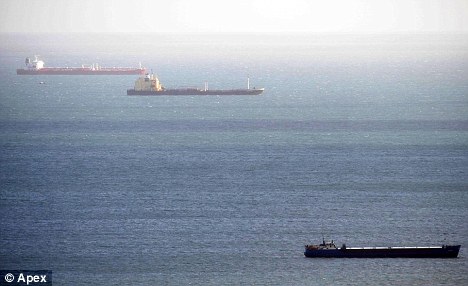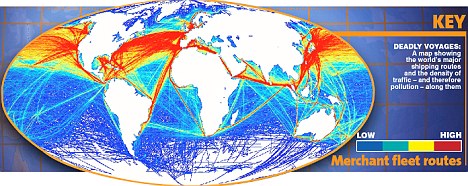Last week it was revealed that 54 oil tankers are anchored off the coast of Britain, refusing to unload their fuel until prices have risen.
But that is not the only scandal in the shipping world. Today award-winning science writer Fred Pearce – environmental consultant to New Scientist and author of Confessions Of An Eco Sinner – reveals that the super-ships that keep the West in everything from Christmas gifts to computers pump out killer chemicals linked to thousands of deaths because of the filthy fuel they use.
We’ve all noticed it. The filthy black smoke kicked out by funnels on cross-Channel ferries, cruise liners, container ships, oil tankers and even tugboats.
It looks foul, and leaves a brown haze across ports and shipping lanes. But what hasn’t been clear until now is that it is also a major killer, probably causing thousands of deaths in Britain alone.
As ships get bigger, the pollution is getting worse. The most staggering statistic of all is that just 16 of the world’s largest ships can produce as much lung-clogging sulphur pollution as all the world’s cars.
Because of their colossal engines, each as heavy as a small ship, these super-vessels use as much fuel as small power stations.
But, unlike power stations or cars, they can burn the cheapest, filthiest, high-sulphur fuel: the thick residues left behind in refineries after the lighter liquids have been taken. The stuff nobody on land is allowed to use.
Thanks to decisions taken in London by the body that polices world shipping, this pollution could kill as many as a million more people in the coming decade – even though a simple change in the rules could stop it.
There are now an estimated 100,000 ships on the seas, and the fleet is growing fast as goods are ferried in vast quantities from Asian industrial powerhouses to consumers in Europe and North America.
The recession has barely dented the trade. This Christmas, most of our presents will have come by super-ship from the Far East; ships such as the Emma Maersk and her seven sisters Evelyn, Eugen, Estelle, Ebba, Eleonora, Elly and Edith Maersk.
Each is a quarter of a mile long and can carry up to 14,000 full-size containers on their regular routes from China to Europe.

Emma – dubbed SS Santa by the media – brought Christmas presents to Europe in October and is now en route from Algeciras in Spain to Yantian in southern China, carrying containers full of our waste paper, plastic and electronics for recycling.
But it burns marine heavy fuel, or ‘bunker fuel’, which leaves behind a trail of potentially lethal chemicals: sulphur and smoke that have been linked to breathing problems, inflammation, cancer and heart disease.
James Corbett, of the University of Delaware, is an authority on ship emissions. He calculates a worldwide death toll of about 64,000 a year, of which 27,000 are in Europe. Britain is one of the worst-hit countries, with about 2,000 deaths from funnel fumes. Corbett predicts the global figure will rise to 87,000 deaths a year by 2012.
Part of the blame for this international scandal lies close to home.
In London, on the south bank of the Thames looking across at the Houses of Parliament, is the International Maritime Organisation, the UN body that polices the world’s shipping.
For decades, the IMO has rebuffed calls to clean up ship pollution. As a result, while it has long since been illegal to belch black, sulphur-laden smoke from power-station chimneys or lorry exhausts, shipping has kept its licence to pollute.
For 31 years, the IMO has operated a policy agreed by the 169 governments that make up the organisation which allows most ships to burn bunker fuel.
Christian Eyde Moller, boss of the DK shipping company in Rotterdam, recently described this as ‘just waste oil, basically what is left over after all the cleaner fuels have been extracted from crude oil. It’s tar, the same as asphalt. It’s the cheapest and dirtiest fuel in the world’.
Bunker fuel is also thick with sulphur. IMO rules allow ships to burn fuel containing up to 4.5 per cent sulphur. That is 4,500 times more than is allowed in car fuel in
the European Union. The sulphur comes out of ship funnels as tiny particles, and it is these that get deep into lungs.
Thanks to the IMO’s rules, the largest ships can each emit as much as 5,000 tons of sulphur in a year – the same as 50million typical cars, each emitting an average of 100 grams of sulphur a year.
With an estimated 800million cars driving around the planet, that means 16 super-ships can emit as much sulphur as the world fleet of cars.








A FREE CARBONE BIG SHIP SOLUTION THORIUM MOLTEN SALT REACTORS.
Comments are closed.